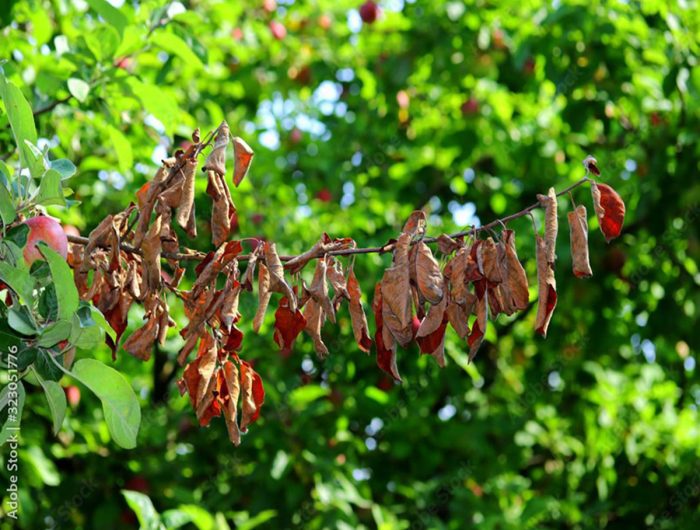
Fireblight, a serious disease affecting apple and pear trees as well as some other shrubs, is now established in Jersey with 66 cases found during Islandwide survey in June.
As a result, the Infrastructure and Environment Department has concluded that the eradication of fireblight is no longer an option and Jersey is revoking is Protected Zone Status. This means that restrictions on importing host plants have been dropped.
Most commercial fruit growers are already aware of the risk of fireblight and are producing fruit using disease-resistant stocks and varieties but orchard owners should employ strict monitoring measures by checking plants and trees regularly.
In guidance issued by the department, the government says traditional Jersey cider apples are probably not resistant to fireblight. Other important hosts in the Island include hawthorn, cotoneaster, rosa, sorbus, cydonia, eriobotrya, mespilus, pyracantha and stranvaesia.
The symptoms are a brown to black necrotic appearance of twigs, flowers and leaves as though they have been burned by fire. Flowers appear water-soaked and then they droop and shrivel, turning brown or black. Fruits darken and shrivel and there is a ‘shepherd’s crook’ of terminal leaves.
Fireblight originated in North America and was introduced to Europe in the 1950s. It was first found in Kent in 1957 before spreading across Wales, south and central England and as far north as Banff in Morayshire.
Importers and retailers can contact the Food and Plant Security Team plantpassports@gov.je for further information and orchard managers can speak to Stephen Thompson or Tom Dixon at Natural Environment Security on (01534) 441600.
Plants can be tested by sealing a sample in a bag and taking it to Howard Davis Farm.
In the meantime, if hedges or trees have been affected or killed by fireblight, here are some steps you can take:
Prune out and burn infected material.
Using a knife, cut and peel back the bark to reveal the reddish-brown staining caused by the disease. Work down the branch until you find clean wood, then cut back 30cm lower down the branch to healthy wood in smaller branches and 60cm in larger ones.
If the entire plant is affected, remove it.
Burning is permitted if it occurs at the same site.
Please contact the Jersey Fire and Rescue Service in the case of larger bonfires.
Ensure that a nuisance is not caused by smoke.
Smaller prunings can be place into domestic waste for incineration.
Prunings should not be composted at home or taken to green waste recycling.
Ensure you wipe down pruning tools between cuts with a 10% household bleach-based solution to avoid spread.
It is important to note that, as far as practical, material should not be transported away from the infected site as this can help spread fireblight. Material should be burned in situ.





One Response
It is always interesting to read the latest edition of Rural Jersey.
I have read the article on fireblight in the Island in your latest issue and the articles in the local press.
I received from the Plant Pathologist in 1979 from the Department of Agriculture, which summarised the action taken when I reported a possible outbreak of fireblight in our garden in a tree and shrub previously obtained from a local garden centre.
It mentions that an advisory leaflet would be sent to me and a survey carried out at a later date in our area. I did not receive a leaflet and am unaware of any survey taking place at that time.
At the time of the visit concern was expressed at the detrimental effect of fireblight to Jersey hedgerows in particular, which I have often reread and wondered how an opportunity was missed many years ago.
At the time Dr Davies was concerned about the arrival of the disease in Jersey and particularly its effects on the local hedgerows.
I do not recall receiving the mentioned advisory leaflet or any survey taking place. Our garden had only been established for 5 years and stocked solely from Ransomes (Garden Centre). Our late neighbours also had a new garden and I understood that their shrubs etc had been obtained by them from outside the Island not sourced locally. I suspected that our disease had arisen from this source. There did not appear to be any follow up in our area in 1980.
I had taken an interest in the disease as I had briefly done a project at the Department of Agriculture on Jersey pests and diseases whilst at college and had worked at East Malling (botanical) research station. This had helped me to identify a possible problem although the department was surprised by my phone call. The department had no authority to remove possibly infected items from our garden, merely ask for our co-operation which was willing given. The pyracantha was removed completely by Dr Davies and his assistant but the pear left although I pruned it heavily to curtail a further spread of disease.
I hope the Department is more vigilant these days.
Isabel Bailhache